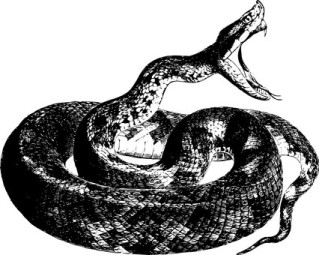
The Snake and the Mirror | Summary
The Snake and the Mirror by Vaikom Mohammed Basheer is a short story of anecdotal nature. The main character of this story is a doctor. He is sitting with a group of children, telling them a story about his past. He begins by asking them whether a cobra has ever wrapped itself around their bodies, before continuing with his anecdote. The doctor used to live in a small, un- electrified room, shared with many mice. He did not have many clothes but for a coat, a doti and a dirty white vest. As he was just setting up his practice, money was sparse- he only had sixty rupees in his briefcase.
That night, he was unable to sleep, despite taking a walk to cool down. He sat on his chair to read a book, before being tempted to look at the large mirror in front of him. He was lost in his own beauty- he was an unmarried doctor, something he believed to be quite the merit. He began combing through his hair to make himself look even more handsome. Then, after continuous inspection in the mirror, he decided to shave his moustache. He wanted to grow a thin one to enhance his appearance. And most importantly, he decided to keep smiling to look the most attractive- once again reminding himself that he was both a bachelor and a doctor.
He hears a noise, but ignores it, too lost in his own reflection. When he finally got up to pace around the room, his mind was a swirl of marvelous thoughts- he wanted to marry a woman doctor someday. Someone who is fat and cannot chase after him even if he makes mistakes. Then, he sat back down to admire his reflection some more when he heard a thud behind him, as though a rope had fallen. The doctor was not concerned, but turned around to look out of curiosity, only to see a huge snake slithering towards him.
The doctor froze in fear as the snake’s hood fanned out and it wrapped itself around his arm. While his body felt like unmoving stone, his mind was running wildly- he was sure that it was the end. He thought he saw the darkness of his future, the certainty of his death. He thought of God in hopes of being saved. Rather than pain, it felt as though a thick molten lead was crushing his arm. He had no strength left, and the snake would bite him at any movement, and he did not have enough medicine at home to treat snake bites. After all, he was just a young and poor doctor. There was nothing special about him, he thought, as he looked at himself in the mirror.
As if God had heard the doctor’s humble awakening, the snake turned to look at its reflection in the mirror, too. It was surprised and entranced, slowly uncoiling from the doctor’s arm and slithering in front of the mirror, lost in its reflection. The doctor got up and ran all the way to his friend’s house, where he bathed and slept. When he returned to his room, he found that a thief stole all his belongings except his one dirty vest- which he was incredulous about, for it would have become white if they washed it. The students asked if the doctor ended up marrying a fat woman, but on the contrary, his wife is thin and reedy. They ask if he saw the snake after that, to which the doctor replied no- it was too lost in its own beauty, and the doctor never saw it again.
The Snake and the Mirror | Analysis
The Snake and the Mirror is written in first person through the perspective of an unnamed student. This can be seen in the beginning, when the doctor asks a question and the following narration is “all of us fell silent,” “we listened attentively”, all of which imply the first-person narrative. However, the focus is not on the student at all, but on the doctor telling the story. The entire story is told as a dialogue- it is as though the readers are listening to the doctor’s tale along with the students. The brief interaction between the students and the doctor in the beginning establishes the context, while the insertion of the students’ questions towards the end brings the reader back from the anecdote to the present setting.
Basheer uses an interesting style of inner monologue- as this story is being narrated by the doctor himself, he is able to convey his exact thoughts and fears at the time, as well as provide a detailed description of the situation. Hence, we see an organized depiction of events, in chronological order. Basheer also employs imagery, symbolism and repetition. The repetition is especially impactful- the doctor constantly reiterates that he is a bachelor and a doctor to express his self-admiration. This is what helps the readers understand the bravado of his character. Further, the gradual change in his tone as well as the change of phrasing after he sees the snake is what marks his development in the short span of time. The main themes of this story are self-admiration, pride, bravado, humility and self-realisations. There are also direct hints to elements of vanity.
In the beginning, the doctor makes it a point to mention his poverty. This is a contrast to his airs and graces about his professional position- he takes pride in being a young unmarried man with an honourable job, but has no problem admitting his financial situation at the time. In technicality, this is a positive aspect. However, we may wonder whether his extensive self-admiration is what leads to this mindset. When the doctor could not sleep, he sits down to read a book, but is tempted by the mirror, saying, “One feels tempted to look into the mirror when it’s near.” Though this is true, it is interesting to note that as he tells the story about his past self, he is making a justification about his actions. This alludes to the fact that now, as a wiser and more mature adult, he understands the unending pride of his younger self.
Here is where we see the themes of self-admiration. The doctor says he is a great admirer of beauty- referring to himself- as he decides how to groom himself to have the best appearance. The mirror symbolises this self-admiration, as it is the tool the doctor uses. We also see a repetition- “I am a bachelor, and a doctor too on top of it!” This shows his high regard for himself, and it only grows with every reiteration. On one hand, self-confidence is a positive thing. However. The doctor’s self-confidence becomes bravado and over-confidence due to his lack of modesty- his self-praise (though it is true that he is indeed an unmarried bachelor) comes across with a sense of superiority. He also wants his wife to be fat so that he can run away if he makes any mistakes, and she will not be able to catch him. Through this statement, the readers see a mischievous side to the doctor- his first thought is escaping from his mistakes rather than being held accountable.
When the snake makes its appearance, Basheer uses descriptive narration within the dialogue to paint a clear picture of the event. He likens its arrival to the “dull thud of a rubber tube falling to the ground”. He also describes the doctor’s shock and fear by comparing him to stone- frozen in shock, completely still and unable to move. We also see an interesting contrast between the body and the mind- while the doctor’s body was motionless, his mind was the opposite. We see Basheer’s clever imagery here in the account of the doctor’s mind- “The door opened into darkness.”, “bright letters outside my little heart the words ‘O God!’”. There is also a comparison made between the snake and a hot molten lead as it crushes the doctor’s arm.
Very importantly, it is only when the doctor worries for his life that he has a moment of self-realisation. The repetitions of “I am a bachelor, and a doctor too on top of it!” fade into “I was but a poor, foolish and stupid doctor.” He had been humbled by the realisation that despite his status as a doctor or a bachelor, he was unable to save himself in such a situation. It was a moment of fear as well as a prick to his ego to realise he was not as superior as he thought- for if he truly was as great, he would at least have medicine in his room. It is only after the doctor has this enlightenment that the snake slithers away. In reality, this may have been a coincidence. But the doctor sees it as an acknowledgement from God, and thus we as readers may also view it as one of the ways of the universe.
The snake is distracted by its own reflection, choosing to admire itself rather than crush the doctor any further. The snake symbolises narcissism or vanity, and in a way, symbolises the doctor himself. Both were lost in their own beauty, drawn to the mirror and full of bravado. Both abandoned what they were previously doing in favour of staring at their own reflection- the snake with crushing the doctor’s arm, and the doctor with reading his book. Ironically, it is the snake’s narcissism that cures the doctor’s own. When the snake is swept away by its reflection, the doctor is brought back to reality, and is chastely humbled.
The doctor runs away to his friend’s house for the night, and comes back to see that everything had been stolen except his uncleaned vest. This is almost amusing, because it alludes to the thief being equally picky about cleanliness even when stealing. Also, when the children ask whether he ended up marrying a fat woman, he answers on the contrary, which shows that not everything goes according to plan, and certain things cannot be dictated. The thievery incident highlights the fleeting nature of material goods. We can also make a connection that appearance is equally fleeting, which leads to the lesson learned by the doctor: the importance of humility and the grounding of one’s self in the reality of the world. In fact, the doctor never saw the snake again- it’s presence itself was fleeting, but the impact it left on the doctor lasted a lifetime. It was a moment where the doctor saw himself as he truly was, and it humbled him into the person he is as he told the story to the children.
The Snake and the Mirror | About the Author
- Born in 1908, Vaikom Mohammed Basheer was an Indian writer and freedom fighter.
- He left school in the fifth form to join India’s struggle for Independence.
- He was known for combining humour and pathos in his work.
- He has been honoured with several awards, including the Padma Shri in 1982.
- He passed away in 1994, at age 86.

